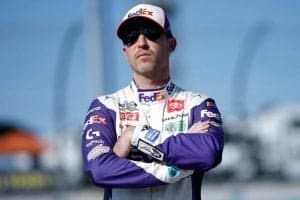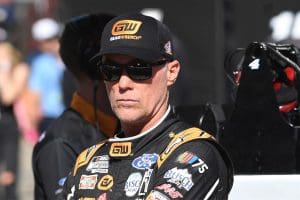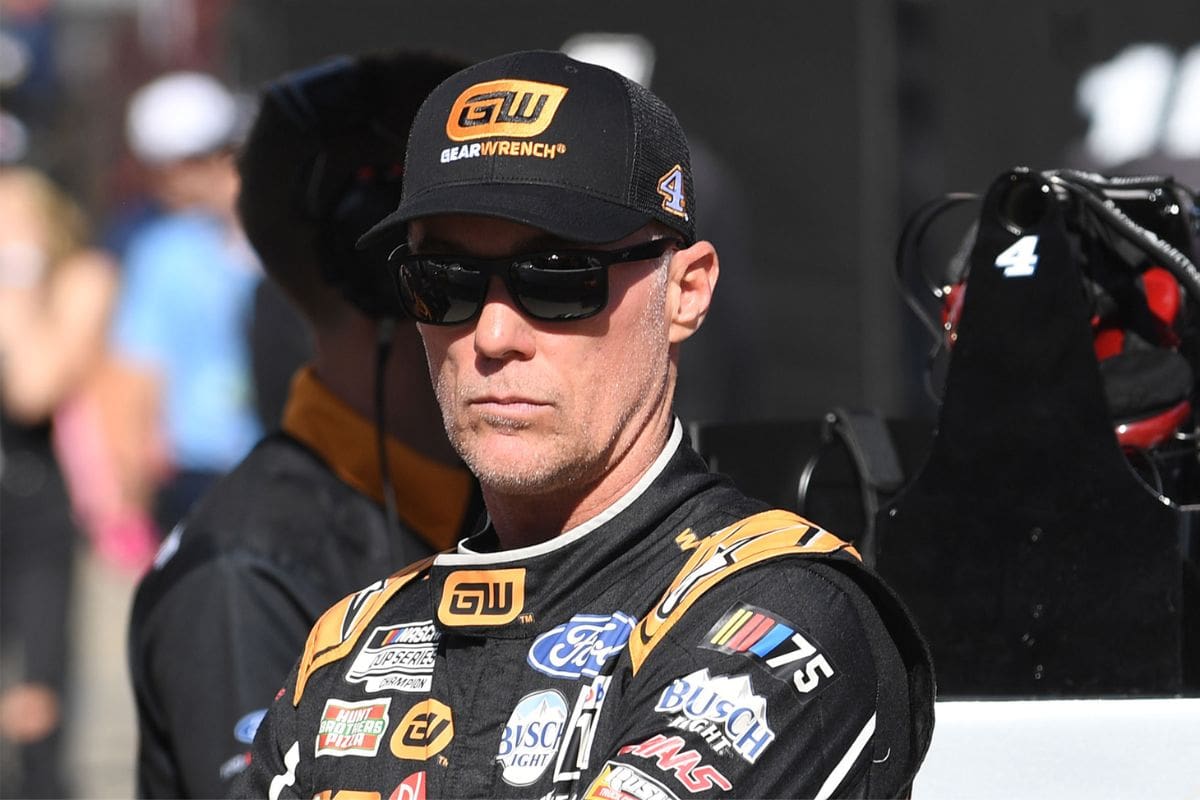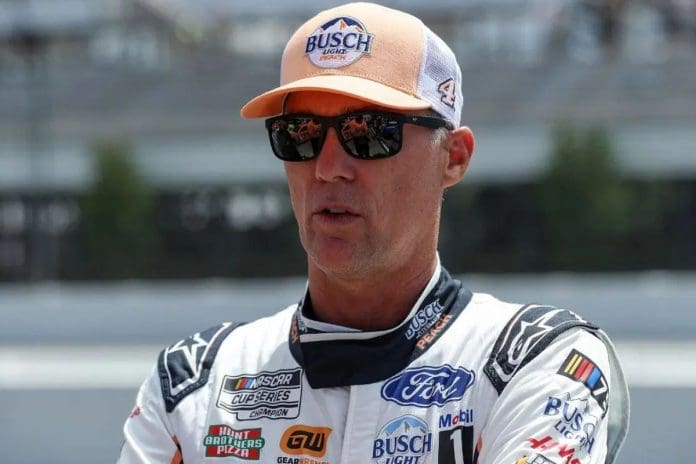Kevin Harvick’s Genius Solution: In the sport of NASCAR, where every second counts and the line between victory and defeat is razor-thin, Kevin Harvick’s proposition of a speed line in the restart zone emerges as a potentially revolutionary solution. This initiative, aimed at reducing the subjective nature of restart violations, posits a fascinating blend of technology and rule enforcement to uphold the sport’s integrity. By recommending a tangible, enforceable standard, Harvick not only addresses a longstanding issue but also invites a broader discussion on the role of innovation in ensuring fairness. As stakeholders contemplate this suggestion, the question arises: could this be the key to eradicating cheating in NASCAR, or will unforeseen challenges render it another well-intentioned yet flawed attempt?
Key Takeaways
- Kevin Harvick proposed implementing a speed line in the restart zone to enhance fairness.
- The solution aims to reduce subjective judgment calls by officials, minimizing cheating opportunities.
- It aligns with technological advancements, ensuring a more precise enforcement of restart rules.
- Harvick’s proposal is part of broader discussions on clear restart rules and penalties for violations.
- This initiative could restore faith and competitive integrity in NASCAR by addressing regulatory ambiguities.
Denny Hamlin’s Controversial Restart at Richmond
In the midst of NASCAR’s drama, Denny Hamlin’s controversial restart in Toyota Owners 400 at Richmond has sparked a significant debate, highlighting the distinct interplay between driver intent and regulatory discretion. The event in question has divided opinions sharply, laying bare the complex decision-making that defines the sport’s regulatory environment. On one side of the divide, Hamlin’s rationale for his premature acceleration is rooted in a split-second decision-making process that drivers often face in the heat of competition. His explanation provides insight into the instincts and strategic calculations that come into play in moments of intense pressure.
Conversely, NASCAR’s response, or lack thereof, to Hamlin’s action has shed light on the governing body’s approach to rule enforcement. By opting not to penalize Hamlin, NASCAR has implicitly highlighted the discretionary nature of its regulatory framework. This decision raises questions about the balance between strict rule adherence and the allowance for competitive discretion within the sport. It emphasizes the delicate equilibrium that NASCAR must maintain between ensuring a level playing field and fostering the unpredictable, competitive spirit that is central to racing.

Lack of Concrete Solutions
Despite the extensive discussions and varied opinions surrounding the controversy, neither explanation has offered a definitive solution to the significant fault exploited by Hamlin during the race. While numerous viewpoints have overwhelmed the debate, none have presented a viable resolution. However, it appears that Kevin Harvick has proposed a solution supported by technology, aiming to keep drivers in line during restarts.
- Frustration among fans and participants who seek a sport governed by fairness and clear rules.
- Erosion of trust in the regulatory body, as stakeholders feel their concerns are not adequately addressed.
- Competitive imbalance, where advantages can be gained not just through skill and strategy, but through exploitation of regulatory ambiguities.
- Stifled innovation, as teams may focus more on finding loopholes rather than pushing the boundaries of engineering and strategy within the rules.
- Potential decline in viewership and sponsorship, as the sport’s integrity is called into question.
Kevin Harvick’s Proposed Solution
NASCAR has made it absolutely clear regarding the permissible speeds for cars entering and exiting the pit road. Any driver exceeding these limits faces penalties. This strict enforcement has effectively kept drivers in line and significantly reduced accidents and mishaps on pit road.
Addressing the pervasive challenges that have emerged from NASCAR’s rule enforcement issues, Kevin Harvick brings forward a novel approach by suggesting the implementation of a speed line in the restart zone. This suggestion, voiced on the Happy Hour podcast, aims at mitigating the contentious restart controversies that have marred the sport’s integrity. Harvick’s proposal is not just a remedy but a strategic pivot towards transparent and fair competition, reflecting a deep understanding of the sport’s nuances and the complexities of rule enforcement.
Analyzing Harvick’s proposition, it’s evident that the introduction of a speed line could serve as a tangible benchmark for drivers and officials, thereby reducing the subjective judgment calls that currently plague restart situations. This solution highlights a shift towards technology and objective parameters in sports rule enforcement, aligning NASCAR with other sports entities that have successfully integrated technological aids to bolster fair play.
“Put a speed line there just like they do on pit roads, make the speed entering the box X amount, give them five miles an hour. Whatever the pace car speed is plus five miles an hour and put a line across the racetrack. And if you’re faster than that, with the length of the car that would be nose at the line of the restart zone, the computer can call a penalty at that particular point.” – (Kevin)

Harvick’s Stand and NASCAR’s Position
Kevin Harvick, a seasoned NASCAR driver, firmly insists that if a clear restart line is established, any deviations or misconduct during races should be assuredly penalized to uphold the sport’s integrity. His stance emerges from a broader concern that NASCAR’s current handling of restarts may leave too much room for interpretation, potentially marring the fairness of the competition. Harvick’s critique, thus, isn’t just about the rules themselves but also about how they’re enforced, highlighting a gap between drivers’ expectations and NASCAR’s officiating.
NASCAR, on its part, seems to be in a delicate position. Officials are evidently reluctant to make judgment calls that could have a profound impact on the race outcome or the championship standings. This hesitancy, while understandable, suggests a tension between the desire for a pure, unambiguous competition and the practical challenges of officiating a sport as dynamic as NASCAR. Harvick’s call for a clearer, more rigidly enforced set of rules on restarts is not just about avoiding controversy; it’s about preserving the essence of racing where skill, strategy, and speed triumph over ambiguity and exploitation.
- Kevin Harvick’s insistence on clarity speaks to a desire for flawless competition.
- NASCAR’s cautious stance reflects the complexities of real-time sports officiating.
- The gap between driver expectations and NASCAR’s rulings highlights a need for dialogue and adjustment.
- The integrity of the sport hangs in the balance, making Harvick’s stance more than just a personal grievance.
- The controversy highlights the eternal struggle in sports between rules and their interpretation.
“I’m at; if you’re painting a line on the track, you should use the line. I mean, if your football team steps on the line, you’re out of bounds right? If the ball doesn’t cross the plane, is it a touchdown?” – (Kevin)
Kevin Harvick has a suggestion on how to regulate restarts. #NASCAR pic.twitter.com/47qg35eFDe
— HarvickHappyHour (@HarvickHappyPod) April 3, 2024
The Need for Rule Changes
Denny Hamlin’s assertion that drivers are becoming more clever about the rules rings true. It’s not just about Hamlin’s restart jump; it’s also about the questionable behavior of drivers behind the leaders. Given the chaotic nature of these restarts and the challenge of monitoring them, Kevin Harvick believes it’s time for NASCAR to rely more on technology to make these distinct calls rather than leaving it to human judgment.
The essence of competitive integrity in NASCAR depends on the fairness and clarity of its rules. As situations evolve, so too must the regulations that govern them to guarantee they remain relevant and enforceable. A rule change concerning restarts is not merely a reactionary measure; it is a strategic move towards preventive future disputes and maintaining the sport’s credibility. The current framework evidently leaves room for interpretation and exploitation, a gap that needs closing to uphold the spirit of competition.
Implementing a revision in the restart rules requires a delicate balance. It must be stringent enough to deter malpractice, yet flexible enough to accommodate the dynamic nature of racing. Engaging with drivers, teams, and stakeholders is vital in formulating a rule that is both fair and enforceable. This collaborative approach would not only enhance the acceptance of the new rule but also contribute to the evolution of NASCAR as a transparent and just competition.
“NASCAR doesn’t want to be in the position to have to make that call. My opinion is take yourself out of that position to make that call. You have a speed that enters the box and then it is what it is. It’s going to police itself at the point. I don’t want NASCAR in the middle of it anymore, and they don’t want to be in the middle of it any more than they are in,” – (Harvick)

News in Brief
Kevin Harvick by demanding for transparent and enforceable restart rules, this solution addresses the persistent issue of subjective judgment calls that have ruined the sport.
It highlights the necessity for NASCAR to adapt its regulations in alignment with technological advancements, thereby ensuring a level playing field and preserving the competitive essence of the sport.
Our Reader’s Queries
Q: Is Kevin Harvick in the NASCAR Hall of Fame?
A: To recognize and honor Harvick’s outstanding career, the NASCAR Hall of Fame recently opened a new Great Hall exhibit entitled, “Kevin Harvick 4Ever A Champion,” displaying the actual race vehicles in which Harvick won five different championships as a driver or an owner, as well as the two title-winning Go Karts.
Also Read: Kevin Harvick Criticizes Hamlin’s Restart: Unfair Advantage Exposed!


